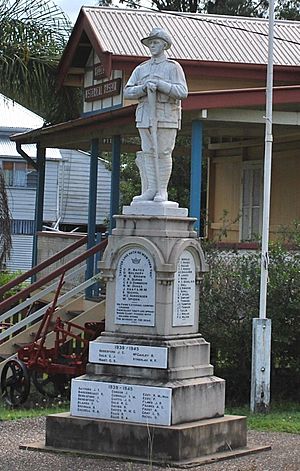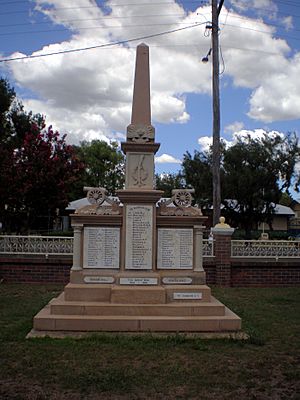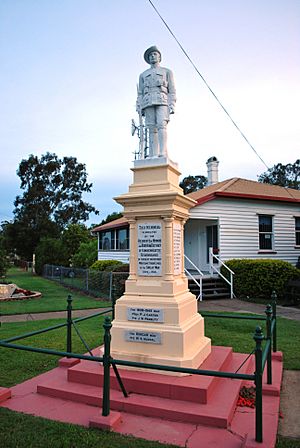World War I memorials in Queensland facts for kids

War memorials are special monuments built in many towns across Queensland, Australia. They were put up to remember the brave people from Queensland who served and died in World War I. These memorials help us never forget their sacrifice.
Contents
Why Were War Memorials Built?
Before World War I, Queensland did not have many public monuments. But after the war, these memorials became very important. They showed how much the war affected Queensland. More than 58,000 Queenslanders joined the war, and over 10,000 of them died. This war had a huge impact on the state.
Even before the war ended, people started building memorials. These monuments were a way for the whole country to show their sadness. For those who built them, these places were like sacred graves. They were stand-in graves for Australians whose bodies remained in battlefields far away in Europe and the Middle East. The British rule was that soldiers who died in war should be buried where they fell. The word "cenotaph" was often used for war memorials. It means "empty tomb."
Remembering All Who Served
Australian war memorials are special because they often remember everyone who served, not just those who died. Australians were proud that their first big national army was made up entirely of volunteers. These men were honored whether they died or not. Many memorials list all the people from a town who served. This helps us understand how much communities were involved in the war. This information is hard to find in other records.
War memorials also show how people felt about the British Empire and their own country at the time. People did not see these loyalties as being in conflict. The memorials also show the skills of local stonemasons, metalworkers, and architects. They give us a peek into what people liked back then.
Different Types of Memorials
Queensland has many different kinds of war memorials. The most common type is a statue of a "digger (soldier)". A digger was an Australian soldier. Communities often chose these statues because they showed the ANZAC Spirit. This spirit represented important Australian qualities like loyalty, courage, youth, and strength.
The digger statue was very popular in Queensland. In other states, like those in southern Australia, the obelisk style was more common. An obelisk is a tall, four-sided pillar that tapers to a pyramid shape at the top. Artists and architects did not always like the digger statues. They were not involved in designing many Queensland memorials.
Where Memorials Were Placed
Early war memorials were often put in cemeteries. They were sometimes built to remember just one soldier who died. For example, Queensland's first World War I memorial was for Victor Denton. It was built in 1915 in the cemetery at Nobby.
As more and more soldiers died, the sadness spread beyond families and friends. Whole communities felt the loss. So, memorials started to be placed in important public spots in towns. Sometimes, they were part of bigger plans, like memorial parks or memorial halls.
Unique Statues
Most statues were made by local stone companies. However, some were made by artists or brought in from other countries. The statue for the Howard War Memorial was imported from Italy. It is very special because the "digger" shown is not an Australian soldier. If you look closely, you can see the statue wears a full Italian Alpino uniform. This includes badges and other gear from Italian mountain soldiers.
Many of the World War I monuments have been updated over time. They now also remember people who served in later wars. Sadly, some memorials have been moved or repaired in ways that changed their original look.
Images for kids






